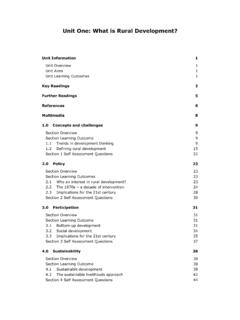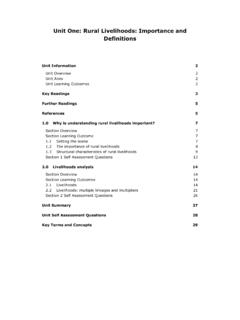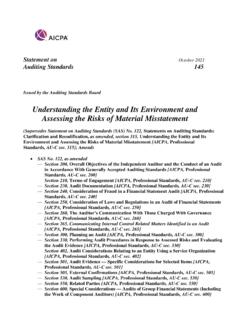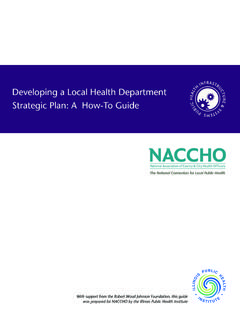Transcription of Unit One: The Earth System and its Components
1 Unit One: The Earth System and its Components Unit Information 2 Unit Overview 2 Unit Aims 2 Unit Learning Outcomes 2 Unit Interdependencies 3 Key Readings 4 Further Readings 5 References 6 The environment 7 Section Overview 7 Section Learning Outcomes 7 What is the environment ? 7 What is environmental science? 9 What is environmental management? 11 The environmental crisis 13 Section 1 Self Assessment Questions 21 The Earth System 22 Section Overview 22 Section Learning Outcomes 22 Systems analysis in environmental science 22 Defining the Earth System 25 Section 2 Self Assessment Questions 32 Unit Summary 33 Unit Self Assessment Questions 34 Key Terms and Concepts 35 P500 Environmental Science and Management Unit 1 SOAS CeDEP 2 UNIT INFORMATION Unit Overview This unit introduces the idea of the Earth System and its main Components : the geosphere, atmosphere, hydrosphere and biosphere.
2 The importance of adopting a systems perspective is outlined. However, in order to understand this approach, it is first necessary to consider some overviews and definitions of key terms and ideas: in particular, the terms the environment , environmental science and environmental management . Understanding these terms is fundamental to understanding the science and management of the Earth System and its Components and processes. In addition, it is helpful to consider an overview of the current environmental crisis , which consists of a range of significant environmental issues together with a variety of other, related economic, social, political and technological issues.
3 The seriousness of the current environmental crisis points to the importance of having a sufficient understanding of environmental science and management in order to respond to the many challenges it presents to policy-makers and other organisations and individuals. Unit Aims To provide overviews and definitions of key terms and ideas, including the environment , environmental science , and environmental management . To present a brief overview of the current environmental crisis , which consists of a range of significant environmental issues and a variety of other, related issues.
4 To explain the value of adopting a systems approach to the environment , identifying the main Components of the Earth System : the geosphere, atmosphere, hydrosphere and biosphere. To highlight the main flows occurring in the Earth System , including the transfer of energy, and to explain the central role of biogeochemical cycles in the transfer of key materials. Unit Learning Outcomes By the end of this unit students should be able to: define the terms environment , environmental science and environmental management state the main features of the current environmental crisis and the key environmental issues associated with that crisis define the Earth System and describe its major Components .
5 Geosphere, atmosphere, hydrosphere and biosphere list some of the main flows occurring in the Earth System , especially the transfer of energy and the cycling of key materials in biogeochemical cycles P500 Environmental Science and Management Unit 1 SOAS CeDEP 3 Unit Interdependencies This unit provides introductory material that underpins Units 2 10, although it is of particular relevance to Units 2 6 in which the main Components of the Earth System are examined in greater detail. This unit also presents a brief overview that is of relevance to understanding the material presented in Units 9 10.
6 P500 Environmental Science and Management Unit 1 SOAS CeDEP 4 KEY READINGS Section 1 Rockstr m J, Steffen W, Noone K et al (2009) Planetary boundaries: exploring the safe operating space for humanity. Ecology and Society 14(2) 32. Section 1 asks what do we mean by environmental management and outlines the current environmental crises . In this paper the authors identify planetary boundaries (or thresholds) in nine key areas of en3vironmental concern beyond which they predict irreversible change in the Earth System . The boundaries identified cover processes operating at the global (or planetary) scale such as biogeochemical cycles and the major circulation systems of the planet; and processes occurring at the regional scale that when aggregated present a serious threat to Earth System functioning.
7 These will be considered in Units 2 6 and include biodiversity loss; pollution and land use change. The aim of this reading is to emphasise the vital importance of understanding these processes for environmental management and also to demonstrate how these processes are interlinked. You may wish to return to this reading again after you have completed Units 2 6. Smithson P, Addison K, Atkinson K (2008) The physical environment . Scientific concepts and methods. In: Fundamentals of the Physical environment , 4th edn. Routledge, London, pp. 3 23. This chapter provides an introduction to Earth System science and explains some key concepts in systems analysis.
8 Section 2 Manion AM (1998) Global environmental change: the causes and consequences of disruption to biogeochemical cycles. The Geographical Journal 164(2) 168 182. This reading provides an account of the significance of global biogeochemical cycles, emphasising their reciprocal relationships and their disruption by human activities. The reading focuses on the major biogeochemical cycles of carbon, nitrogen and sulphur. P500 Environmental Science and Management Unit 1 SOAS CeDEP 5 FURTHER READINGS Park C (2001) environment in crisis. In: The environment : Principles and Applications, 2nd edn.
9 Routledge, London, pp. 3 32. Park C (2001) Population and environment . In: The environment : Principles and Applications, 2nd edn. Routledge, London, pp. 33 57. Park C (2001) Environmental systems. In: The environment : Principles and Applications, 2nd edn. Routledge, London, pp. 58 98. Smithson P, Addison K, Atkinson K (2008) Energy and Earth . In: Fundamentals of the Physical environment , 4th edn. Routledge, London, pp. 24 42. This chapter examines the importance of energy in environmental systems, including the main transfers, transformations and flows of energy in the Earth System . Smithson P, Addison K, Atkinson K (2008) The Earth System and the cycling of carbon and nutrients.
10 In: Fundamentals of the Physical environment , 4th edn. Routledge, London, pp. 515 536. In this chapter, the major cycles of the Earth System are outlined, including the carbon and nitrogen cycles. P500 Environmental Science and Management Unit 1 SOAS CeDEP 6 REFERENCES Barrow CJ (2005) Environmental Management and Development. Routledge, London. Park C (2001) The environment : Principles and Applications, 2nd edn. Routledge, London. Smithson P, Addison K, Atkinson K (2008) Fundamentals of the Physical environment , 4th edn. Routledge, London. UNDP (undated) Millennium Development Goals.














